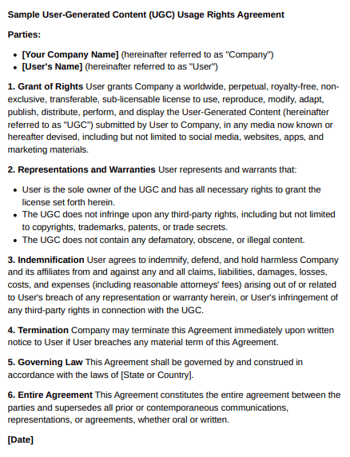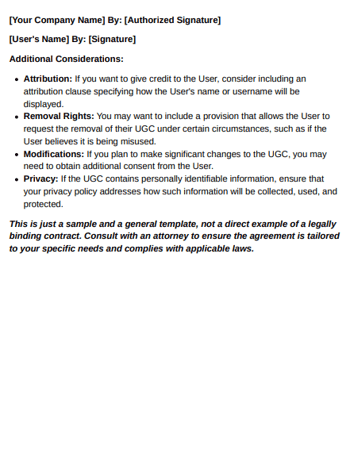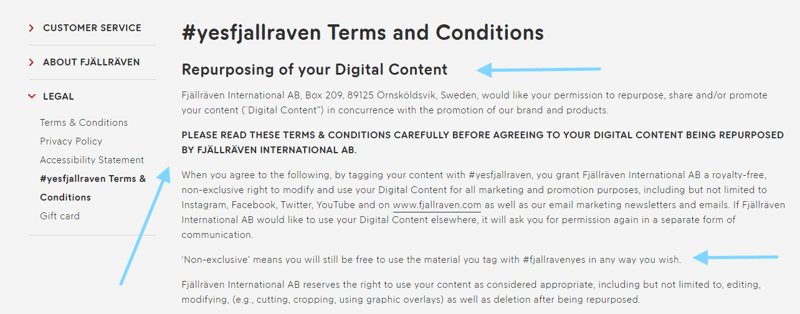
What Are UGC Usage Rights?
UGC usage rights are permissions obtained by brands to promote user-generated content. These permissions apply to social media photos and videos, UGC on your website and more.
For reference, a usage rights agreement will cover the following:
- How long a brand can use the content (90 days vs. one year vs. forever)
- Where the brand is allowed to use the UGC (TikTok vs. Instagram)
- Whether the brand can promote the content in ads or commercials
- Whether the brand can edit the content (ex: cropping a photo, taking a clip from a video)
- Whether the brand has exclusive rights to your content
Brands must get a creator’s explicit consent to all of the above. This is typically done through a written agreement.
Wait, Brands Need Permission to Use UGC?
Yes, 100%!
Creators own their user-generated content until they accept an agreement and explicitly grant permission to brands to use it. It’s a common misconception that brands “own” the rights to a piece of content if they’re tagged or featured in a social post.
"Permission" in the context of getting UGC refers to the explicit consent a brand must obtain from the content creator before using their work. This permission can be granted in several ways:
- Written permission. This is a clear, legally binding document or email where the creator explicitly grants usage rights. Offers strong legal protection.
- Contracts or licensing agreements. These are formal documents outlining usage terms, duration, and compensation. Provides comprehensive legal clarity.
- Verbal permission. Granted in informal settings but difficult to enforce. This should be followed up with written confirmation.
- Platform-based permission: Granted through social media interactions (ex: replying with a hashtag like #Yes[BrandName]. Useful but should be documented for legal protection.
UGC permission doesn’t always require a formal contract.
However, having something in writing in a simple email or agreement provides legal protection and clarity. Written permission is always preferable because it clearly documents the creator's consent and the terms of use. This reduces the risk of misunderstandings or legal disputes
When in doubt, ask for explicit permission and get it in writing!
Types of Usage Rights for UGC
The following permissions fall under the umbrella of usage rights to UGC:
Perpetuity Rights
Want to own a UGC photo or video forever with no questions asked? You’ll need to get perpetuity rights. Typically, UGC usage rights are granted for a specific timeframe (such as one year). Creators can also set time-limited rights.
Exclusive Rights
This means that your brand is the only brand granted usage rights to a post and the creator can’t sell the same piece of content to another brand. This typically comes at a higher cost when it comes to compensation.
Commercial Rights
These rights allow you to use UGC to drive profits, including commercial purposes such as social ad campaigns. Here's an example of how a brand might track UGC usage rights for ads in a spreadsheet:

Attribution Rights
In some cases, creators may want credit when their content is used. For example, they may want their name or social handle to appear in your promotion.
As noted in our guide to creator licensing, the types of permissions you need depend on your goals and budget.
Sample UGC Usage Rights Agreement
Here's a snapshot of what a UGC rights agreement looks like. It may as a digital document or static on a brand's website.


This is just a sample and general template, not a direct example of a legally binding contract. Consult with an attorney to ensure the agreement is tailored to your specific needs and companies with applicable laws.
How to Request UGC Rights as a Brand
Okay, scenario time.
Let’s say you’re a hot sauce brand and you see a TikTok creator’s recipe video featuring your latest sauce go viral. The video racks up millions of views. You desperately want to use the video in an upcoming Spark Ad campaign while people are still buzzing.
Great! So what happens next? How would you proceed?
Well, there’s no one-size-fits-all approach to obtaining UGC rights. Here are some options:
Social Comments
Depending on how you ask and how clear you are about your intentions, comments on UGC can indeed act as written consent. Asking via comments is acceptable for simple reposts from creators but not so much for ads.
DMs
More private than comments, DMs can help your request for usage rights seem a bit more personal compared. Especially if you personalize your outreach!
Email
Emails allow you to go into more detail and get things moving faster. For example, you can attach contracts to emails with less back-and-forth or confusion. Here are some email templates to help you ask for UGC.
UGC Platforms
This risk also highlights why brands are collaborating with through UGC platforms where usage rights agreements are baked in. This approach is faster and likewise most convenient for creators.
Terms and Conditions Pages
Most brands have public guidelines for users who submit UGC or publish it for social media. This not only helps brands avoid penalties but also makes UGC moderation more straightforward as creators have crystal clear expectations. Check out the example below from Fjällräven:

Is there a “best” way for brands to request user-generated content rights? We asked one of our creators their opinion on how they preferred to be contacted Here’s what she said:
Hmm. DMs would probably be the best choice. My second choice would be email. I don’t think comments are ideal at all. I’ve seen a lot of brands choose this route, though.
Brands have plenty of options to request UGC. How you do it depends on your bandwidth and the types of campaigns you plan to run. Regardless, be respectful to your influencers and UGC creators.
Should Brands Expect to Compensate UGC Creators for Usage Rights?
Almost always, yes.
There aren’t really standard rates for user-generated content. The amount of legwork and potential commercial use for any given piece of UGC varies so much from creator to creator and campaign to campaign.
Generally, brands should expect to compensate creators for UGC usage rights in social ads. Here’s what a creator from our network had to say:
I typically charge brands a content usage rights fee based on the amount of months the content is being used.
We also asked her if there are different usage expectations for photos versus videos:
Yes! I think it’s most common for creators to charge a percentage of the actual content price, and typically videos are more expensive than static. So I would say the usage fee would most often be different per content type, possibly even per platform it would be used on
For example, many of our creators charge brands $100+ for their TikTok Spark Ad codes. Some double that, others 5x that! It all really depends on the scope of the brand's campaign and budget, the work of the creator and the UGC rate that the creator is comfortable with.
Here are some variables and factors to consider as creators set their rates:
- The more effort put into creating a post, the higher the price
- The better the post performs (ex: engagement, reach, clicks), the higher the price
- The more eager the brand is to amplify the post, the lower the price.
- For sponsored post fees, creators may charge a percentage of the brand's original payment for the organic sponsored post (ex: 30% of the brand's payment).
Either way, We always encourage brands to compensate creators for their work and likewise for creators to empower themselves.
What Happens If a Brand Doesn’t Ask for Permission?
It depends. Consequences range from call-outs from unhappy influencers and takedown requests to legal action.
Penalties and backlash will be much more severe for brands attempting to use influencer content in ads or run commercials featuring creators without their explicit consent. In these cases, you’re profiting off their work.
Legal action is a worst-case scenario for brands but it’s not even a situation worth putting yourself in. Even without legal action, getting called out by creators can be devastating for your brand and reputation among influencer communities.
Again, this is exactly why brands are turning to user-generated content platforms with built-in usage rights.
How to Get Instant UGC Usage Rights from 1000s of Influencers and Creators
Speeding up the process of getting content rights goes hand in hand with scaling UGC campaigns.
That said, we understand how much of a bottleneck content rights management can be. Much like UGC moderation, brands have to be mindful when automating the process.
That’s where a platform like Stautsphere can help.
Our micro-influencer marketing software matches brands with vetted creators from our influencer network using 250+ unique, first-party data points.
Again, our creators grant content usage rights as soon as they’re accepted into our network. That means you can reuse and repurpose content ASAP. This includes two-click Spark Ad codes which allow you to turn your top creator videos into TikTok ads instantly.
-1-1.png?width=500&height=490&name=SparkAds-1%20(1)-1-1.png)
Want to learn more about our platform? Contact one of our experts to see how we can help you earn guaranteed, rights-ready influencer content at scale.
Disclaimer: We're influencer marketing specialists, not lawyers ourselves! This content is not legal advice and you should definitely consult a legal professional based on your needs and questions. We do not make any guarantees as to the accuracy or completeness of this information and take no liability or legal obligations for your use of this information.
